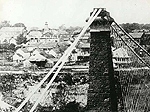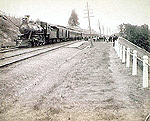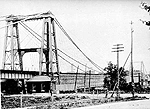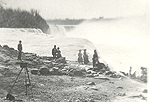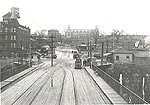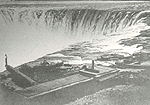|
the
The following photographs are of Niagara Falls during the 1800's
to early 1900's.
The Town of Clifton courtesy of Niagara Falls Public Library The Town of Clifton circa 1880's. A stone pillar of Roebling's Suspension Bridge is in the foreground. The Fire Company tower can be seen in the distance (upper left).
The Ruins of the Clifton Hotel
On December 31st 1932, the Clifton Hotel was once again destroyed by fire. The fire started in the North wing and could not be controlled until most of the structure lay in ruins
Cripps Eddy located along the Canadian shore of the Niagara River just north of the Whirlpool. In the 1920 picture water diversion was still minimal. The Great Gorge Railroad bed can be seen along the opposite side of the river on the American shoreline. A recent picture shows the much lower water level and the remnants of the Great Gorge Route.
Upper Steel Arch Bridge in 1927 courtesy of Niagara Falls Public Library The Canadian side of the Upper Steel Arch Bridge (Honeymoon Bridge/Falls View Bridge) in 1927. The Lafeyette Hotel can be seen in the lower right of the picture next to the water tower.
Falls View Train Station circa 1920's
The Falls View Station was an observation area along the top of the moraine which provided the best area from which to view the Falls. Passenger trains slowed and/or stopped to allow passengers a chance to disembark in order to view the mighty Falls of Niagara before continuing on their journey. Today the Fallsview Tourist District remains a favorite viewing area to see the Falls. Today this Fallsview area is lined by large hotels and the Minota Observation Tower. It is interesting to note the slant of the telegraph poles which line the railbed. This is caused by "Ground Creep" or rather ground slippage.
The Ice Bridge, circa 1880's
A classic stereograph of the Great Ice Bridge of the 1880's.
Buck's Suspension Bridge 1886-1896
More and more demands were being placed onto the existing Railway Suspension Bridge that was completed in 1855. Trains crossed more frequently and became larger and their loads heavier. Soon the stresses placed upon the existing bridge structure were becoming too great and safety became a big concern. The work of renovating the Railway Suspension Bridge was carried out by Leffert L. Buck, an American engineer who later went on to become famous for his design of great steel arch bridge which eventually replaced the suspension bridge. The beauty of the second bridge was sacrificed for one of much greater strength. Increasing trade and commerce demanded that wood and stone be replaced with steel. Slender steel pylons replaced the thick stone towers. Steel beams and trusses replaced the wooden frame work. The entire renovation was completed by 1886. No accidents occurred during construction and with little interruption to rail traffic.
Prospect Point at the American Falls circa 1830 courtesy of Niagara Falls Public Library The lands surrounding American Falls were undeveloped as late as the 1870's. This area today is known as Prospect Point and is part of the State of New York Reservation Park at Niagara. Note, Terrapin Point Tower (1829-1870) in the distance.
The Queenston-Lewiston Ice Jam circa 1938
On January 23rd 1938, a sudden wind storm on Lake Erie sent a deluge of ice down river and over the Falls. Within twelve hours the river below the Falls was jammed with ice of such enormous proportions that the ice shield extended the length of the entire lower Niagara River with the exception of the Whirlpool Rapids. This was the same ice bridge which resulted in the collapse of the Upper Steel Arch Bridge (Honeymoon Bridge) at 4:20 p.m. on January 27th 1938. A Niagara Falls-Lewiston Railroad tunnel along the American shore can be seen in the distance. This tunnel no longer exists.
Skiers on Prospect Mountain circa 1890
The 1800's brought to Niagara very cold winters with an enormous water fall. The result was massive ice bridges as seen above. The ice mounds became so large that they resembled mountains for those daring to ski.
The Upper Steel Arch Bridge, circa 1897 courtesy of Niagara Falls Public Library The Upper Steel Arch Bridge (Honeymoon Bridge/Falls View Bridge) was built in 1897-1898 by the Pencoyd Bridge Company of Philadelphia. It was located 14 feet closer to the American Falls than the suspension bridge it replaced. At that time it was the greatest steel arch bridge in the world. This is a picture of the Canadian side. The Lafeyette Hotel is along the left edge and the Oneida Community is in the upper center.
The Table Rock and the Horseshoe Falls, circa 1860's courtesy of Niagara Falls Public Library The Table Rock at the edge of the Horseshoe Falls was once undeveloped.
Date last updated:
February 13, 2012
THANK YOU FOR VISITING the NIAGARA
FALLS PAGE
|
||||||||||
